How often do we actually go fishing when our chances of catching are at their highest? It’s a question I’ve been forced to ponder lately, with some tricky sessions on the bank.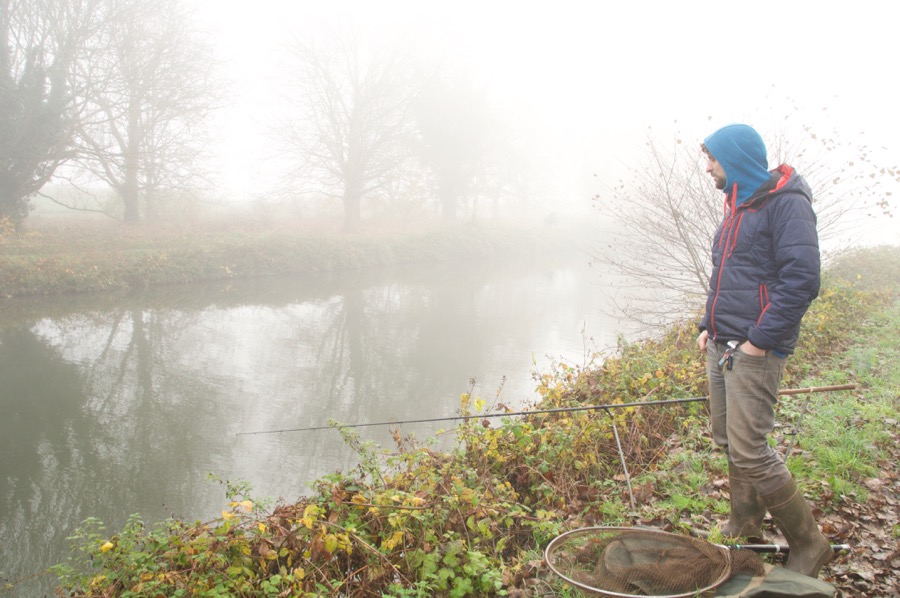
Experience alone will often give us a hunch as to when will be a productive time to fish, but life tends to make other plans. As intently as you might study the weather, or try to plan ahead, you have to take what you can get. Which could mean the wrong day of the week, or the hours of the day when it’s unlikely to work.
One easy way to find a couple of hours is to set your alarm clock early and rise with the lark. The first hour of light is probably my favourite time of all to go pike fishing, but Exeter Canal has been rock hard even in this usual golden time.
Meanwhile, my only other full day off, I managed to make the drive to Simpson Valley Fishery in North Devon for a spot of perch fishing. I’ll spare you the drama, but after getting my pole working again, I thought I’d target them around the classic features, using chopped worm and prawns.
Bloody hell was it cold! The name of the coarse lake “Lower Fuzzy” was probably an accurate way to describe my head state, after a hours drive in the dark. Cold, crisp and not altogether encouraging.
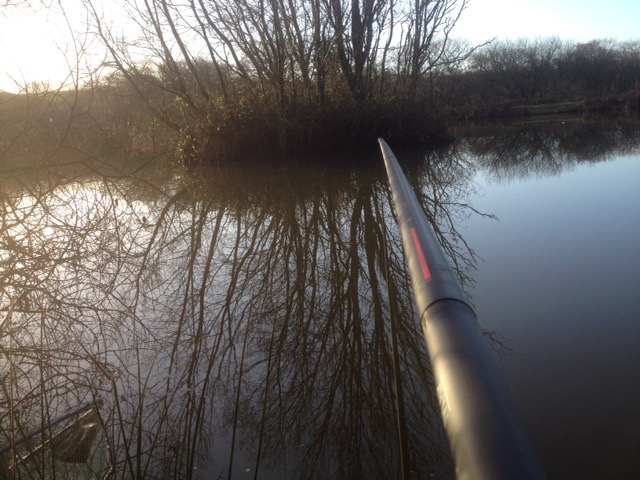
In all but the worst conditions, half a cup of chopped worm will tend to bring bites quite quickly and often a big perch. But on this day, both chop lines were flat. Odd, because I’d found 3-4 feet of water with excellent cover. A tiny perch and a skimmer were all I found the in the first hour.
Almost out of distraction I then fished a pinkie line and added a bit of liquidised bread, just to see if I could get some silvers going. It was good fun to get a few bites for a while. At first I wondered about taking one or two for perch bait, but thought better of it. Most would have been too big really, with some nice roach in this pond.

So where were the perch? I decided to move to the next peg, just to try some different features- and here I could much tighter to the island with 13m of pole. And then it lashed it down.

I was already fairly wet by the time I bothered with the umbrella. There were pinkies climbing out of their tub and everything sticking together and all the usual nonsense that makes anglers hate rain.
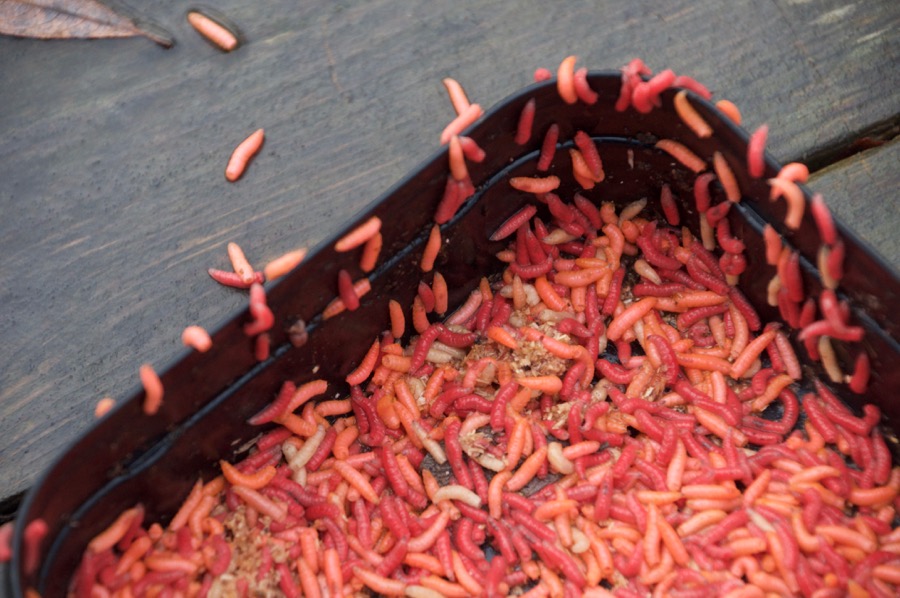
When you’re not catching, you start to question things. I fished fairly robustly, with large baits and rigs of 4lbs main to 3.5 hook length and fairly thick hollow elastic. I didn’t want to take any chances if I hooked a large perch- and if they snag you on light line you’ve had it. But was I too heavy? The whole afternoon the guy opposite had roach and skimmers fishing into open water. And there I was biteless, hell bent on getting a better perch.
At around three o’clock, the light got that dirty, early winter evening colour and I felt more confident again. Now or never. In went half a fresh helping of chopped worm and prawn. I had been feeding a few bits of prawn most of the day to the features. I don’t go too crazy, but I think that where the smaller stuff is likely to eat the feed after an hour or so, it’s good to offer some bigger chunks of bait that only the perch can manage.
The fish still wouldn’t oblige until it was getting properly dark. The worm was only getting bumped by the odd skimmer, so I tried a bigger piece of prawn. These are brilliant baits- and I like the larger, raw king prawns. The trouble with using them whole is that the bait is big and has a funny shape. And when you’re fishing fairly light you don’t want a huge hook (I like a Preston or Drennan barbless wide gape sizes 10-12 for worm and prawn baits). So I sort of cut my king prawns into 2-3 juicy slivers of bait. I seem to hook more fish this way- as I suspect that whole prawns can easily bounce out of a fish’s mouth without the hook setting.
After most of a day without a touch on the prawn, it was perhaps a brave move, but I quickly had a positive bite and perch of around three quarters of a pound. Then, ten minutes later, the float bristle went under again and something took a lot more elastic. It fought well, but as soon as I had it well away from the island there was little danger.

I was lucky to have someone on hand to get a picture or two. Paul Tuson, from Bideford, is a Fallon’s Angler reader it turns out. I think he recognised me, but then thought better of it- the guy should have a fly rod, not a pole surely? The fish went 2lbs 3oz anyway- and after spending a good few hours wet and cold you can probably understand why it felt bigger and better earned. By that time it was virtually dark.
Chilly days like these make you wonder whether to keep the lie ins but instead fish the dusk more often. Because the same pattern followed on Exeter Canal, where my two previous pike fishing sessions had been blanks.
I had barely 90 minutes on the next occasion, sneaking a couple of rods into the car for a bit of post Christmas shopping therapy. What an infuriating fish these pike can be! I fished on a slight bend- and suddenly the recently seemingly fishless water at the city end woke up. A bite and a jack within 40 minutes, what was happening?
From the talk in the local tackle shop, you might think the pike are extinct. It’s not true. Some get illegally taken, yes. But a lot of the others are just cagier probably down to our activities.
Which is another reason why I continue to fish singles a lot of the time. A gently popped up smelt or other small fish is ideal for this with a wide gape size 3/0 through the back. You won’t get away with a whole herring, but for lamprey section or smallish sea and coarse baits it’s ideal- so much less damage to nets, hands and pike too! I set my indication to register any slight movement and strike immediately, and more often than not the pike is beautifully cleanly hooked.
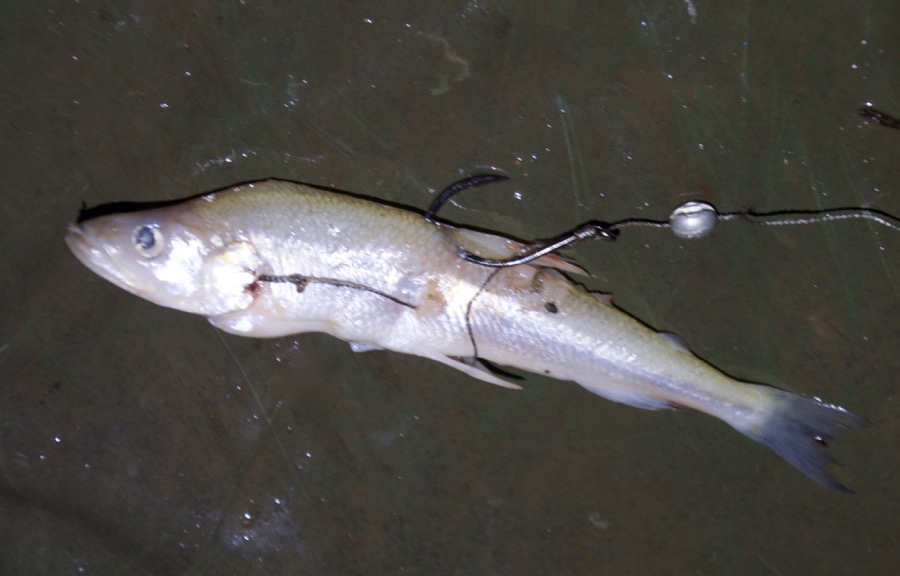
As bitterly cold as it was, I got bites quite close in, down the margin slope in about 8 feet of water. An experimental cast or two helps here, because while it’s always good to be near cover, you don’t want to be right in the weed. So one other good tips is to keep moving your baits every few minutes. This needn’t be constant, but every ten minutes is sensible. If you feel the tough resistance of weed you can then clear the bait and have a recast.
I had another jack of five or six pounds, with some damage on the back (old cormorant or otter attack?) before it got properly dark. I was in mid mind, between staying and packing up at this point. But I had a few tippy-tappy little bleeps on the right hand rod- and then missed a half-hearted run. I’d always rather strike early than risk deep hooking- and quite often a fish will come back for the bait if it doesn’t feel the hooks.
It was a pain setting up the bobbin in the wind, so I did something daft and just tightened up a little and put the bait runner on. Ten minutes later the next run was brutally clear and obvious, the pike taking like a hooked carp. It took a little longer to get a rather stronger fish up to the surface, the single hook just visible in the scissors of the jaw.
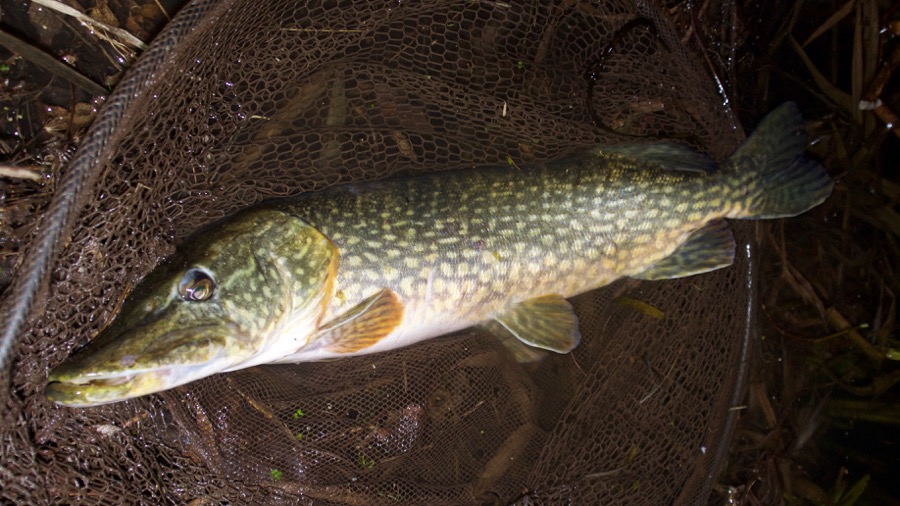
The fish looked battle scarred and old, perhaps just shy of double figures. Like a working class pike that had endured decades of booze and punch ups. I love the fish with character, but am always extra careful if they look like they might be old fish, so she went back quickly without being weighed.
The other thing I’d done that might have helped on the canal was to throw in the guts of the fish I’d caught earlier in the week with Kari Furre, my artist friend and fish leather expert. For those yet to see it, she has been working on special editions of Crooked Lines, in fish leather.

It has been a great collaboration so far and I have enjoyed making friends with this fascinating lady, who makes all kinds of strange and beautiful art from fish skin and other natural materials. The idea of her making something out of a fish she had caught herself was just too good to pass up. So we went to Hatchlands Fishery for a spot of fly fishing near Totnes.
Although our worlds are very different, Kari has a definite same connection to water and I knew pretty quickly she’s enjoy it. When not doing her art, she is a keen wild swimmer.
And she was a good student, picking up the basics of casting quite quickly. What is harder to prepare someone for is that first hooked fish- and it didn’t take long. She had cast a lure twelve yards or so out, there was a bulge behind the fly. The rod suddenly kicked over, Kari let out an unexpected profanity and the rest is history!

I love these magic moments of someone catching their first fish. Above all it was the sheer excitement that got Kari. But after we’d dispatched the fish, she looked on it with a different eye, wondering what could be made of those beautiful colours. She added another a couple of hours later- so we left with two each for the table, not to mention that precious skin.
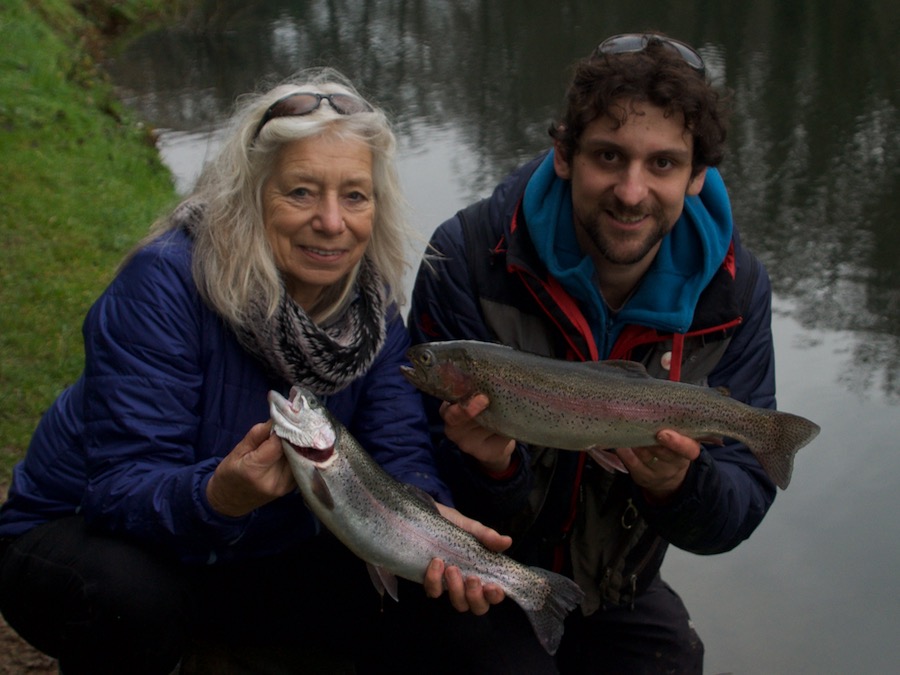
You’ll have to watch this space on that score, but that afternoon I learned the dark art of trying to remove the skin of a fish whole and undamaged! Most of us only remove the skin on a fish we have grilled, so it is a very different experience to “skin” one. That layer of skin is surprisingly tough and takes some getting off. This also explains why it makes great leather. And obviously for both practicality and beauty, the fresher the better. The day had a great symmetry, in fact, as I had shown her my art and she returned the favour. I cannot wait to see what she makes of the skins- just look at that pink streak of colour!
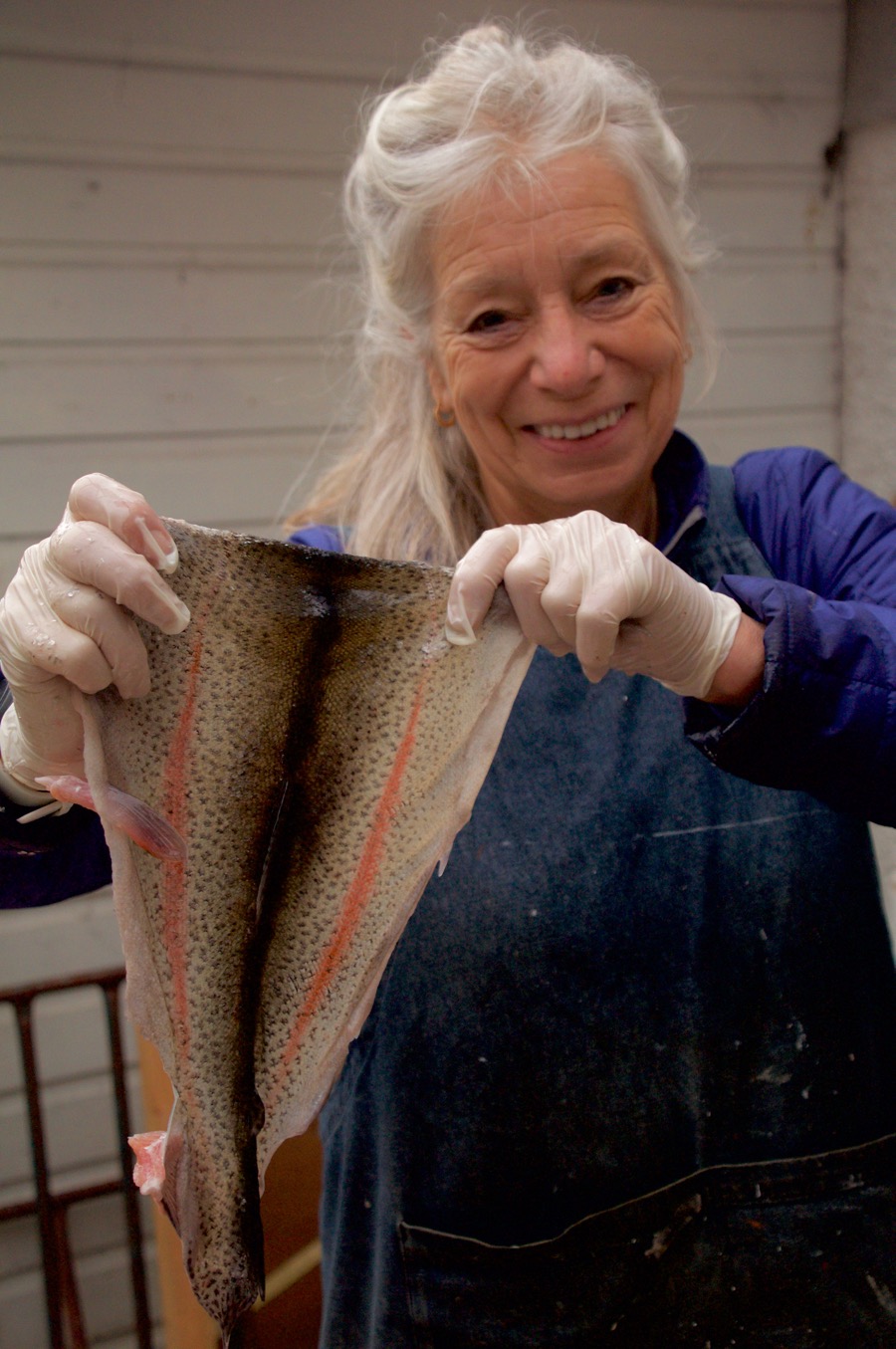
In other news, we should be fairly close to the new fish leather-bound editions of Crooked Lines. I now have four rough versions- beautiful but not quite perfect- which will sell for less than the price of a mint, scale-perfect version! Should you want to know more or reserve a book, you are very welcome to contact me.
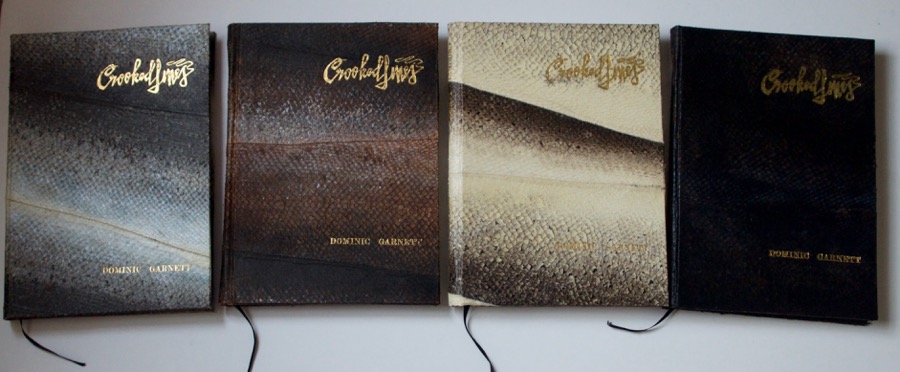
(Above: Crooked Lines special editions, L to R: Natural salmon oil tanned, willow dyed salmon, oil-dyed salmon, black dyed salmon).
Until then keep fishing, have a great festive break and I wish you all a very Happy New Year.


